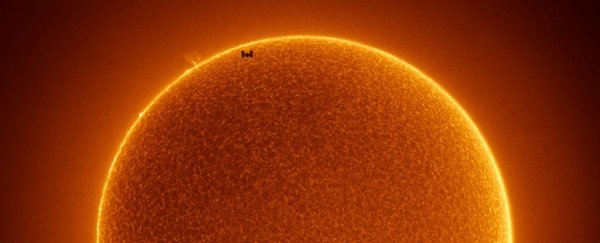The International Space Station (ISS) is the single biggest spacecraft ever built, and one of the most sophisticated machines put in orbit by human kind.
Against the fiery backdrop of our Sun, however, the achievement - roughly the size of a football field - looks decidedly puny.
A dazzling picture, taken in broad daylight by photographer Rainee Colacurcio, shows just how insignificant the ISS truly is. One of her shots (above) was recently featured on Astronomy Picture of the Day (APOD), and we've included another one below:
Solar transit from Edmonds Beach edited- small prominences brought out and colorized:) #iss #InternationalSpaceStation #isslive #nasa #science #solaraystem #astronomypicturesdaily pic.twitter.com/Y0Dqw0HRXd
— Rainee Tubbs-Colacurcio (@RaineeLC) June 19, 2019
Using a dedicated hydrogen-alpha solar scope, which can help us view the Sun in all its blazing glory, Colacurcio managed to catch a glimpse of the ISS at the precise moment it passed between Earth and our Solar System's magnificent centre.
Appearing like a dark splotch in the corner of the disk, the station's H-like silhouette can barely be made out against the burning background. And while it may look like a sunspot at first, it's far too uniformly dark to be mistaken for one.
According to the caption on APOD, most sunspots have a dark central umbra, followed by a lighter penumbra ring surrounding it, and - obviously! - no solar panels.
Pictures like this one are quite hard to manage. As the ISS orbits Earth every 90 minutes, the station's passage across the Sun has to be perfectly timed. In this case, the image was put together using two photos that were taken simultaneously: one of the space station transiting the Sun, and the other of the Sun's surface.
Without a sunspot to speak of, the ISS stands out against this strangely uniform background as the only blemish on the star's surface, because we're currently in a solar minimum - a deeply quiet phase of the Sun's mysterious 11-year cycle.
Even so, the Sun has been particularly quiet lately, and Colacurcio's image captures this exceptionally well.
"For reasons not yet fully understood, the number of sunspots occurring during both the previous and current solar minima have been unusually low," states APOD.
